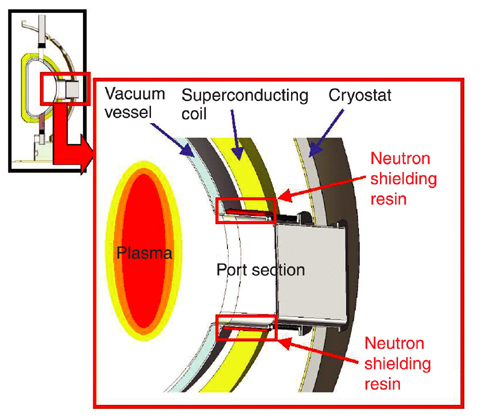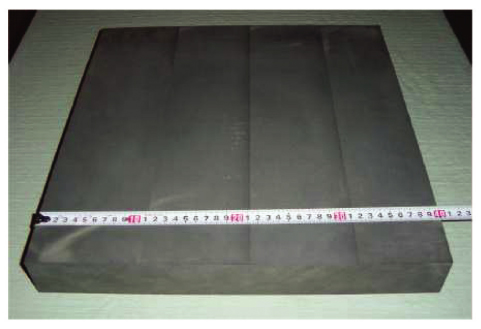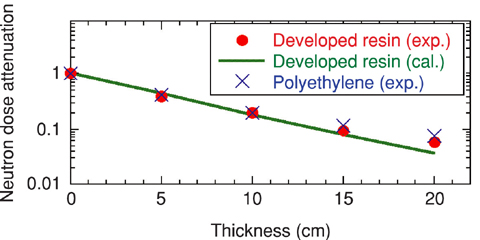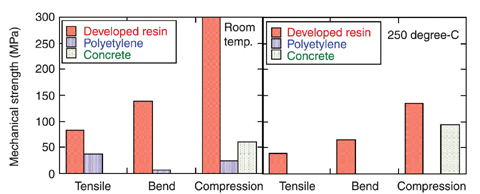
Fig.3-26 Cross Section of JT-60 Superconducting Modification with Enlarged View of the Port Section

Fig.3-27 Test piece of the developed resin

Fig.3-28 Neutron dose attenuation in the new resin and polyethylene using 252Cf source

Fig.3-29 Mechanical strength of the new resin and existing neutron shielding materials
In the JT-60 modification there is a device with a new addition of a superconducting coil. The device will be operated with deuterium plasma and a deuterium beam, but no blanket is planned. Therefore, some shielding structure is required for the DD neutrons (En=2.45 MeV) in order to suppress nuclear heating at the superconducting coil. The DD neutrons will be shielded mainly by the water in the double walled vacuum vessel. However at the port duct where the double wall structure is not available, another neutron shield material will be required. Such a neutron shielding material is required to be resistant to the baking temperature of the vacuum vessel, 150~300°C. The neutron shielding material, such as resin, will be installed outside the vacuum vessel of the device, between the port wall and the superconducting coils (Fig.3-26).
When the plasma quenches, a big electromagnetic force is generated in the vacuum vessel and the structure materials. Therefore, it is necessary to have mechanical strength in the neutron shielding material. In addition, lightness of the materials in the narrow part around the port section is indispensable. Neither heat resistance nor strength is found in borated polyethylene. We evaluated resins as the raw material. Ten kinds of test materials were produced. Six consisted of epoxy-based resin, two consisted of the glass fiber, one consisted of polyurethane and the last one consisted of phenol-based resin. Only the phenol-based resin and the glass fiber were useful above 250°C. Further improvement of the phenol-based resin to reduce production cost was carried out.
In the next step, modification of the resin so that it will capture the thermal neutrons was investigated. At first, we tried to mix boric acid into the resin. However, it was difficult to produce neutron shielding material having more than 5cm thickness. We tried developing a neutron shielding resin by mixing boron carbide (B4C) with phenol-based resin that had improved heat-resistance (Fig.3-27). The density of the resin was 1.8g/cm3.The heat-proof temperature was more than 300°C by the determination of the temperature of deflection under load in a test according to the Japanese Industrial Standard (JIS).
Mechanical strength characteristic of the developed resin and existing neutron shielding materials are shown in Fig.3-29. The developed resin has enough mechanical strength at both room temperature and 250°C. The resin was compared with concrete. The volume of the resin was 1/2 that of concrete. The weight of the resin was 1/2˜1/3 that of concrete. Thus, the resin used is expected to be much lighter than the concrete.
Finally, the neutron shielding performance of the developed resin using 252Cf neutron source was almost the same as that the polyethylene (Fig.3-28). Thus, a neutron shielding resin that could be used in a high temperature environment was developed. This resin is suitable for application to the port section of the vacuum vessel.